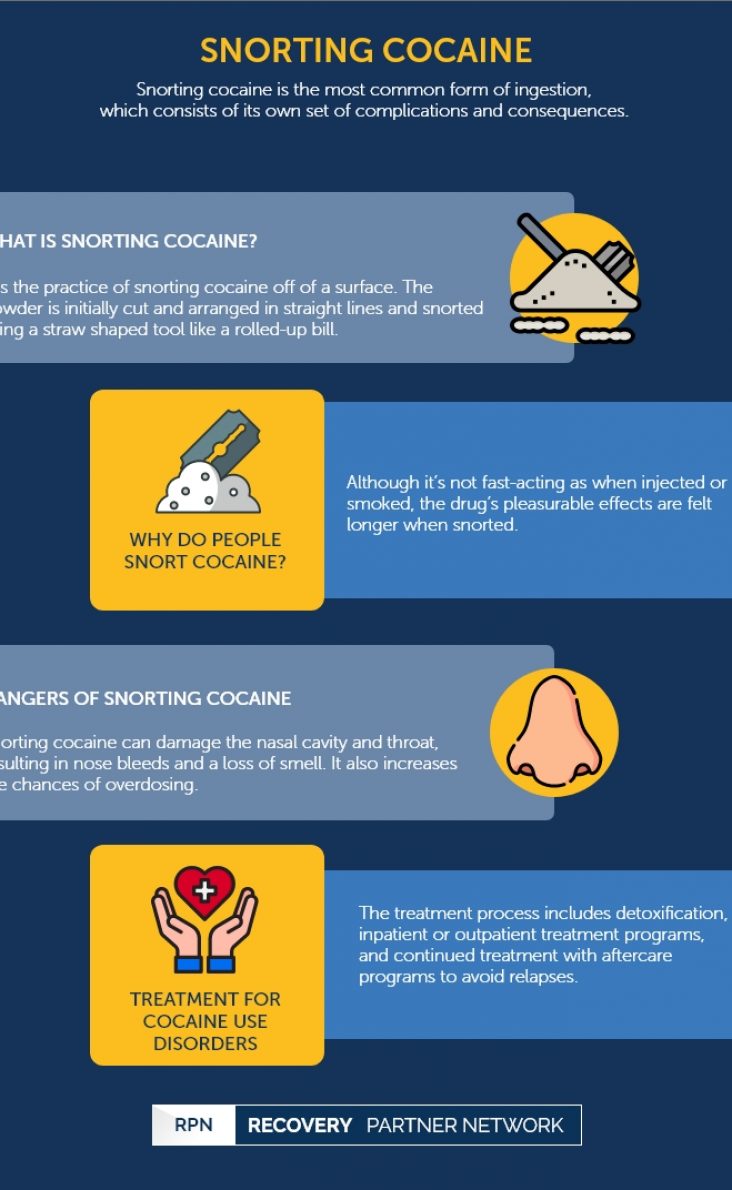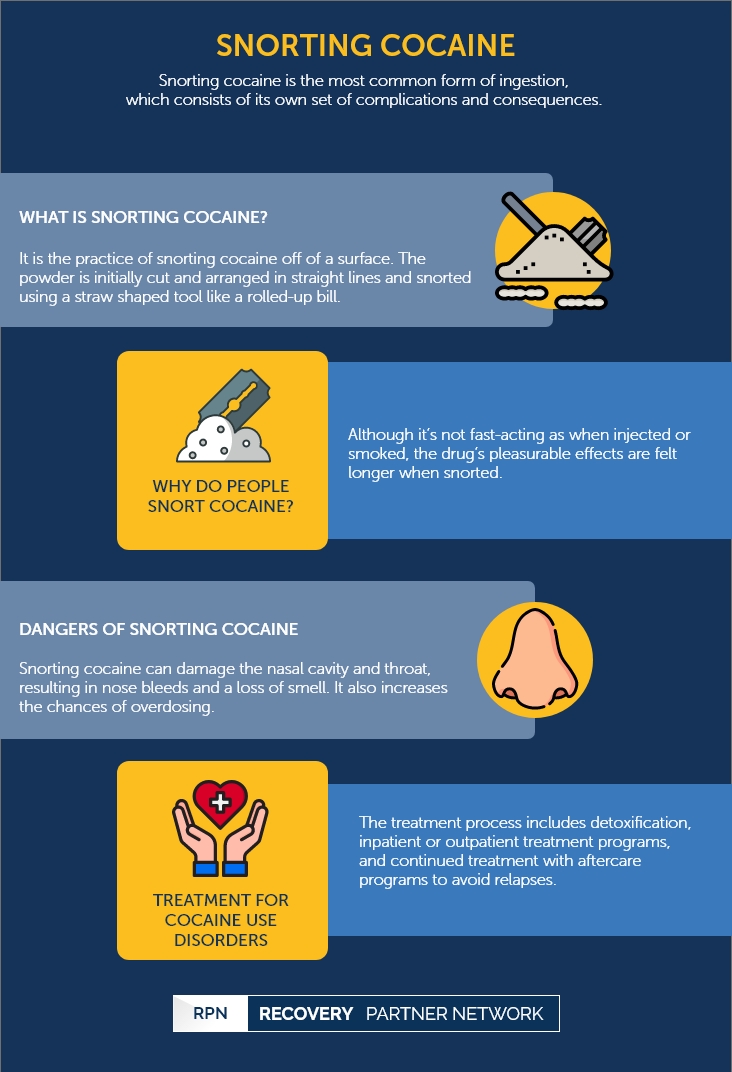Snorting cocaine is the most common form of ingestion, which consists of its own set of complications and consequences.
Snorting Cocaine
Illicit drugs
- Ayahuasca addiction – Abuse
- Baclofen addiction
- Black tar heroin addiction
- Cannabis addiction
- Cocaine dependence
- Crack cocaine addiction
- DMT addiction abuse treatment
- Does Marijuana Kill Brain Cells?
- Ecstasy addiction
- Gabapentin addiction
- gamma-Hydroxybutyric acid addiction
- Hallucinogen
- Heroin addiction
- Illicit drug addiction
- Inhalant addiction
- Cocaine
- Ketamine addiction
- Lysergic acid diethylamide addiction
- Mescaline addiction
- Methamphetamine addiction
- Meth Labs: Cooking up Addiction
- Meth Mouth
- Microdosing
- Phencyclidine addiction
- Psilocybin mushroom addiction
- Sage of the diviners – Addiction
- Shooting Heroin
- Shooting Methamphetamine
- Smoking Cannabis
- Speedball
- Synthetic cannabinoids
Cocaine | Table of Contents
What is Snorting Cocaine?
Cocaine is a stimulant that is generally consumed in many ways, such as smoking, snorting, and injecting, but the most common method of ingestion is snorting. Small amounts of cocaine are referred to as bumps, which are commonly snorted off of long fingernails or keys. Larger doses of cocaine are usually cut and arranged in straight lines and snorted, generally through a straw-shaped tool, often a rolled-up bill. Such doses are commonly referred to as rails or lines.
FAQ
- Why is snorting cocaine dangerous?
- What are the damages caused to the nose while snorting cocaine?
- What are the physical signs of someone snorting cocaine?
- How does snorting cocaine affect the user?
Snorting cocaine can increase the risk of addiction, lung infections, brain abscesses, overdose, and cause irreversible damage to nasal tissue.
Snorting cocaine can cause bone loss, collapsed nasal passages, nasal obstruction, sinusitis, chronic halitosis, and a hole in the nasal septum.
Some of the physical signs that someone is snorting cocaine are frequent nosebleeds, mood swings, runny nose, and sniffling.
Snorting cocaine produces a lengthier high and increases a persons’ tolerance to cocaine. Snorting cocaine also comes with its own set of health complications.
Why Do People Snort Cocaine?
Snorting cocaine isn’t the quickest way to absorb the substance and activate its effects. Although it’s not fast-acting as when injected or smoked, the drug’s pleasurable effects are felt longer when snorted. However, snorting cocaine can cause numbness to the throat, mouth, and tongue. The effects felt through snorting generally last for around 15 to 30 minutes.
Cocaine functions by entering the bloodstream and working its way to the brain. When an individual inhales cocaine, it binds itself to the soft tissues in the nose, where it is gradually absorbed into the bloodstream. Cocaine releases high levels of dopamine in the body and parts of the brain that induces pleasure. The build-up of these chemicals provides the user with a boost of energy and alertness referred to as a high.
The primary reason many prefer to snort cocaine instead of injecting or smoking is that the effects tend to last relatively long, and it is convenient and less intrusive than other methods.
The Nose
The nose is a very vital and complex part of our body. It contains 400 different types of receptors that help us identify and distinguish smells. The nose is able to distinguish between 1 trillion different scents. The nose also helps us taste food and, to some degree, filters the air we breathe. When air travels through the nostrils, it flows through mucous membranes and small hair that act together to trap and lockdown particles like dirt and dust that are unsafe for the lungs.
Dangers of Snorting Cocaine
Snorting cocaine can cause damage to the nasal cavity and throat that could result in nose bleeds and a loss of smell. However, the most dangerous aspect of snorting is its ability to increase an individual’s tolerance much faster than when consumed through other methods. Subsequently increasing the chances of experiencing an overdose.
While all methods of ingestion can lead to overdose, snorting carries its own set of dangers. In particular, snoring affects the sensitive tissues in the nose and throat directly. When the use of cocaine becomes a daily habit, the damage to soft tissue can slowly worsen. The first sign of nasal tissue damage is a runny nose. Although it doesn’t sound as serious, this is generally caused by a sinus infection or contaminated tool and environments used to snort cocaine off from.
Although it is unpleasant, a sinus infection does not pose a significant threat, but when cocaine is snorted more regularly, it leaves the nose with no time to heal. Chronic irritation in the nasal cavity can lead to nose bleeds and inevitably towards reduced blood flow to the affected area over time. The restricted blood flow to the affected area further aggravates the situation by not allowing the area to heal. Wounded tissues with no blood flow will eventually die.
The delicate tissues in the upper nose and palate will suffer first, causing holes to appear in the nasal cavity. The frequently cited side effect of snorting cocaine is the deterioration of the septum (tissue separating the nose), which causes the nose ridge to gradually buckle. This long-term damage is known as the saddle nose deformity, which is caused by damage to cartilage and soft tissue. When infections in the nose intensify, they can also spread to surrounding organs. In chronic users, untreated sinus infections migrate to the eyes, which can permanently impair vision, cause spine and brain infections, and even result in hearing loss.
Treatment for Cocaine Use Disorders
The initial treatment for all forms of addiction starts with detoxification. Followed by counseling and other forms of rehabilitation therapies that are effective in addressing and treating psychological dependence on cocaine. Depending on the severity of one’s addiction, patients can receive their treatment at an inpatient or outpatient treatment center. The duration of treatment for each individual may vary depending on the needs and requirements of each patient. After the successful completion of inpatient or outpatient treatment programs, patients must continue their treatment with aftercare programs to avoid relapses and prolong their recovery.
Recovery Partner Network
We aim to educate and empower. If you feel our library of resources does not cover your specific need, reach out to us, and we would be happy to help.
STATISTICS
© Copyright 2024


